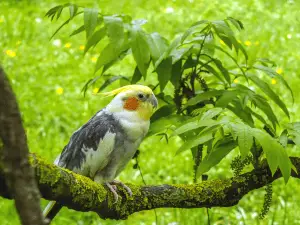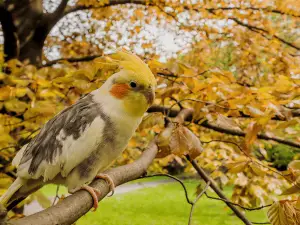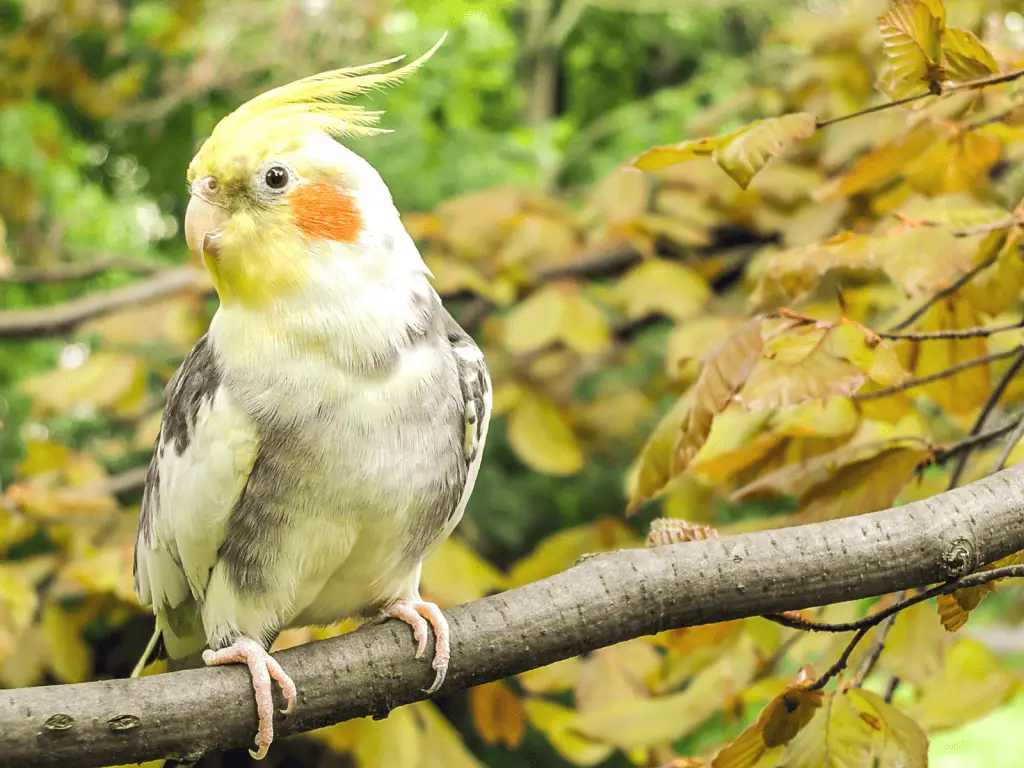Cockatiels are beautiful, sociable birds that make wonderful pets. But one thing many people don’t know about them is how fast can cockatiels fly. Have you ever wondered just how quickly your pet cockatiels can take to the skies? Read on to find out more about cockatiel flight speed and other fun facts!
Cockatiels are small parrots native to Australia. They have a wide variety of colors, from gray and white to yellow and orange, but all share the same distinctive crest of feathers on their heads. Their wingspan is usually around 10-12 inches, which makes them perfectly sized for flying indoors or in aviaries outdoors. So just how fast can these little guys go?
Understanding Cockatiel Flight
In order to understand the speed of cockatiel flight, it’s important to have a basic understanding of how flight works in birds. Birds have specialized bones and muscles in their wings that allow them to generate lift and control their flight path. The speed of a bird’s flight is influenced by a variety of factors, including its weight, wing structure, and overall fitness.
Cockatiels belong to the parrot family, and their flight capabilities are comparable to other birds in this group. In general, parrots are known for their strong and agile flight, which allows them to maneuver through tight spaces and avoid obstacles with ease. When compared to other bird species, however, cockatiels have a relatively short wingspan and lighter body weight, which can impact their overall flight speed.
Measuring cockatiel flight speed

Measuring the flight speed of cockatiels is a challenging task, as it requires specialized equipment and techniques. In order to accurately measure a bird’s flight speed, researchers often use high-speed cameras and GPS tracking systems. These methods allow them to record the bird’s movements in real-time and calculate its speed with great precision.
Studies on cockatiel flight speed have shown that these birds are capable of reaching speeds of up to 30 miles per hour in outdoor environments. However, when flying indoors, cockatiels tend to be a bit slower, with average speeds of around 20 miles per hour. This is because indoor environments are typically more cluttered and challenging to navigate, which can limit the bird’s speed and agility.
Physical characteristics of cockatiels
Cockatiels have adapted several physical features that help them during flight. Their feathers are designed to reduce drag and increase lift, allowing them to fly with greater efficiency. They also have a lightweight bone structure, which helps keep their overall weight down and allows them to reach higher speeds more easily.
Along with being able to fly quickly, cockatiels also have impressive endurance. They can fly for hours on end without tiring, making them ideal for long-distance journeys such as migrating between breeding grounds or searching for food.
How fast can cockatiels fly compared to other birds?
When compared to other birds, cockatiels are not particularly fast flyers. Their top speed is around 25-30 mph, while some of the larger raptors can reach speeds up to 200 mph! However, they make up for their lower speed with their maneuverability and agility in the air. This makes them a great choice for aviary hobbyists who want to watch their birds in action.
How far can a cockatiel fly?

Cockatiels are capable to fly long distances, but they typically don’t venture too far from their home. In the wild, cockatiels can fly up to 30 miles in a single day while searching for food or migrating between habitats. But pet birds tend to stay closer to home and rarely travel more than a few miles away. This is why it’s important to keep cockatiels in a secure aviary or cage when they are not being supervised. That way, they can explore and fly around without getting lost!
Factors that affect cockatiel flight speed
In addition to environmental factors, there are a number of other factors that can impact the speed of cockatiel flight. For example, the bird’s health and fitness level play a significant role. A cockatiel that is in good physical condition will be able to fly faster and more efficiently than one that is overweight or suffering from health problems.
The age and experience of the bird can also have an impact on its flight speed. Younger birds, for example, may not have fully developed their flight muscles and may not be able to fly as fast as older birds. Additionally, birds that have had more opportunities to fly and practice their skills are likely to be faster and more agile in the air.
Temperament and personality can also affect the speed of cockatiel flight. For example, a bird that is naturally bold and confident may be more willing to take risks and fly faster than a bird that is more timid and cautious. Additionally, birds that are kept in stressful or hostile environments may not fly as fast or as confidently as birds that are well-cared for and living in a positive living environment.
Tips for keeping your pet cockatiel safe and healthy while flying
Though cockatiels are capable of flying quickly, it is important to remember that they are still relatively fragile birds. To keep your pet bird safe and healthy, make sure to provide them with an adequate amount of space to fly in and avoid having too many obstacles or furniture pieces in their flight path. It is also a good idea to limit the time they spend in the air and give them plenty of rest after a long flight.
How to encourage fast flight in cockatiels?
If you’re a cockatiel owner and want to help your pet reach its full flight potential, there are several steps you can take. Firstly, make sure that your bird is getting enough exercise. This can be achieved by providing plenty of opportunities for your bird to fly and explore its environment. A spacious and well-equipped cage is also important, as it will give your bird plenty of room to stretch its wings and fly.
Additionally, it’s important to maintain a healthy diet for your cockatiel. Feeding a balanced diet that is high in protein and low in fat will help keep your bird in good physical condition and ready to fly.
Finally, make sure to avoid stressors and promote a positive living environment for your bird. This can be achieved by providing plenty of social interaction, avoiding loud noises and sudden movements, and keeping the cage in a quiet and calming environment.
Fun facts about the behavior and habits of cockatiels in the wild
Cockatiels are social birds and amazing creatures that can be seen in large flocks and enjoy interacting with other members of their species. They also have a wide variety of vocalizations, which they use to communicate with each other. In the wild, cockatiels prefer open grasslands or shrubs in areas where there is plenty of food available. They are also known for quickly learning new behaviors when given the opportunity, making them an entertaining pet to keep.
Finally, cockatiels often use the air currents created by the wind to soar up into the sky and gain height more quickly. This behavior is known as “thermalling” and allows them to cover large distances with ease.
Cockatiels and their diet
In the wild, cockatiels feed mostly on seeds, grains, fruits, and vegetables. In captivity, however, they require a more balanced diet that includes pellets or other formulated foods as well as fresh produce. Their diet should also include plenty of protein, such as cooked eggs or boiled chicken.
In addition to their regular diet, cockatiels should also be provided with toys and other objects to chew on. This helps keep their beaks strong and healthy, which is essential for a successful flight.
Cockatiel’s cage
Cockatiels need space to fly and stretch their wings, so it is important to provide them with a large cage that is suitable for flying. The cage should also have plenty of perches for your bird to rest on, as well as enough room for toys and other objects in which your bird can play or chew. Additionally, the cage should be cleaned regularly to ensure a healthy and safe environment for your pet.
The cage door should also be kept closed at all times to prevent your bird from flying away. Finally, make sure to provide your cockatiel with plenty of safety in their cage, as well as a good view of the outdoors so they can watch the birds and other animals outside.
Final thoughts: How fast can cockatiels fly?
Cockatiels are amazing birds that can fly quickly and gracefully when given the space and opportunity to do so. The flying abilities of these birds are strongly influenced by their diet, exercise, and living environment. To encourage faster flight in your cockatiel, make sure to provide them with plenty of space to stretch their wings, a balanced diet that is high in protein, and a safe and calm living environment without any stressors. With the right care and attention, your pet can reach its full flight potential!
Other suggested articles:
Can a Cockatiel Fly Without Tail Feathers?
- How Can Your Other Pets Be Harmful To Your Cockatiel
- How Cockatiels Show Affection
- How Do Children Make Cockatiels As Pets
- How Do Cockatiels See
- How Do Cockatiels Sleep
- How Do Fumes Affect Your Cockatiel
- How Do You Care For Your Cockatiel Everyday
- How Do You Choose A Cage For Your Cockatiel
- How Do You Medicate Cockatiels
- How Do You Provide Your Cockatiel With Water
- How Do You Select Your Cockatiel
- How Do You Tame A Cockatiel
- How Does A Cockatiel Got Her Name
- How Far Can A Cockatiel Fly
- How Far Can A Cockatiel See
- How Fast Can Cockatiels Fly
- How Good Is A Cockatiels Memory
- How Long Can A Cockatiel Go Without Food
- How Long Can Cockatiels Go Without Water
- How Long Do Cockatiels Actually Live For In Captivity
- How Long Do Cockatiels Live In Captivity
- How Long Does It Take For Clipped Wings To Grow Back
- How Long Does It Take For Cockatiel Tail Feathers To Grow Back
- How Long Should A Cockatiel Be Out Of Its Cage
- How Often Do Cockatiels Lay Eggs
- How Often Do Cockatiels Poop
- How Often Should A Cockatiel Go To The Vet
- How Should I Set Up My Cockatiels Cage
- How To Bathe Your Cockatiel
- How To Bird Proof A Room
- How To Bond Two Cockatiels
- How To Bond With A Scared Cockatiel
- How To Build Trust With A New Cockatiel
- How To Calm A Stressed Cockatiel
- How To Care For Your Cockatiels Health
- How To Care For Your Cockatiels Nails
- How To Catch A Cockatiel
- How To Clean Cockatiel Nose
- How To Clip A Cockatiels Nails
- How To Discipline A Cockatiel
- How To Find A Cockatiel That Flew Away
- How To Get A Cockatiel Back Into Its Cage
- How To Get A Cockatiel To Go On Your Hand
- How To Get A Cockatiel To Like You
- How To Get A Cockatiel To Sit On Your Finger
- How To Give Your Cockatiel Exercise
- How To Grow Millet For Cockatiels
- How To Hold A Cockatiel
- How To Introduce A New Cockatiel To Another
- How To Keep A Cockatiel Quiet
- How To Keep A Cockatiel Warm 10 Tips And Tricks
- How To Maintain A Clean Cockatiel Cage
- How To Make Your New Cockatiel Feel At Home
- How To Manage Multiple Cockatiels In One Household
- How To Monitor Your Cockatiels Health
- How To Prepare Your Cockatiel For Travel
- How To Prevent Your Cockatiel From Becoming Stressed
- How To Recognize And Treat Cockatiel Anxiety
- How To Take Care Of An Older Cockatiel
- How To Tame A Cockatiel That Bites
- How To Tame Your Cockatiel
- How To Teach A Cockatiel To Talk
- How To Tell If A Cockatiel Is In Pain
- How To Tell The Age Of A Cockatiel
- How To Toilet Train Your Cockatiel
- How To Train A Cockatiel To Fly To You 8 Steps
- How To Train A Cockatiel To Poop In One Place
- How To Train Naughty Cockatiels
- How To Transition Your Cockatiel To A New Cage
- How To Transport A Cockatiel To The Vet
- How To Trim A Cockatiels Beak
- How To Trim Your Cockatiels Wings



